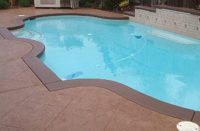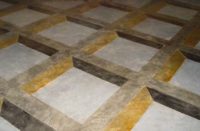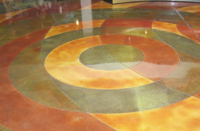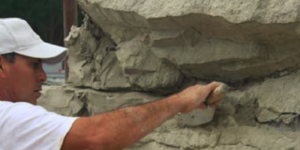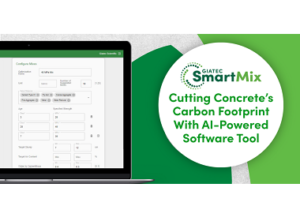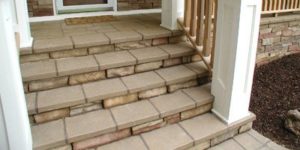 Indiana-based C2 Products Inc. offers an environmentally friendly, durable way to seal and stain concrete with its flagship products, The Bean and The Jelly Bean.
Indiana-based C2 Products Inc. offers an environmentally friendly, durable way to seal and stain concrete with its flagship products, The Bean and The Jelly Bean.
The Bean is a penetrating sealer containing soybean oil, surfactant and water that can be applied to pervious concrete as well as wood and nonpervious concrete. Its formula is designed to seep into surfaces.
When water comes in contact with a Bean-treated surface, the water will disperse, not bead. The Bean leaves a transparent finish on concrete and a satin-to-transparent finish on wood.
C2 Products founder Jim Miller says The Bean is fine enough to get into pervious concrete quickly without clogging its openings, while it is also very stable once it penetrates. “With a carrying agent that’s comprised of approximately 60 percent water, its makeup allows for a nice mist on the surface and won’t plug the holes of pervious concrete,” he says.
Also, The Bean improves abrasion resistance because it improves surface strength, he says.
The Bean’s ability to keep pervious concrete properly hydrated is yet another significant benefit. “In pervious concrete, you need moisture to be present long enough for the cement paste to hydrate,” Miller says. “The hydration gives it strength, which will keep the aggregate in place down the road and avoid what we call raveling. ” (Raveling is when the aggregate particles lose their bond and become loose.)
“With pervious concrete, we’re worried about moisture loss right away at the surface,” he says. “The Bean controls moisture loss by holding some in and letting some out.” On nonpervious concrete, The Bean provides some moisture control, but its primary advantage is protection, Miller says. It penetrates regular concrete as it cures.
Also, it repels moisture when concrete is under blankets or plastic, preventing condensation reentry marks from appearing. Miller says this last feature makes it the best product to use when covering concrete with insulated blankets. “If it’s sprayed onto a surface in the winter before blankets are put down, it will protect against water and ice when the blankets come off,” Miller says. “And additional prep work won’t be required if you decide to put an acrylic down later. It’s a cool insurance policy for your concrete.”
Application of The Bean is similar on pervious and nonpervious concrete surfaces -remove any residual membrane sealer or curing compound from the surface, allow it to dry, and remove any oil stains. Shake the product thoroughly, then apply with a sprayer. (Coverage depends on surface porosity, as more product is required for more porous surfaces.) A milky film will appear after application and be absorbed into the surface. Simply clean up with dish soap and water. The Bean is designed to protect concrete for two years.
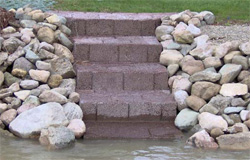 To add color to pervious concrete surfaces while sealing, add a 10-ounce pigment pack called The Jelly Bean to each gallon of The Bean prior to application. Two applications sprayed in opposite directions are typically required to achieve the best hue.
To add color to pervious concrete surfaces while sealing, add a 10-ounce pigment pack called The Jelly Bean to each gallon of The Bean prior to application. Two applications sprayed in opposite directions are typically required to achieve the best hue.
The small, pre-measured amount of soy-based liquid pigment in each Jelly Bean keeps contractors who use the packets from having to purchase more pigment than they need. “Every contractor’s goal is to increase efficiency,” Miller says. “If you have a small job, you can just add what you need, and it’s much easier to store packets than gallon-sized buckets on a shelf.”
Steve Hostetler, of Hostetler Concrete in Ellettsville, Ind., recently used The Jelly Bean pigment packets in red and brown along with The Bean to enhance a brick-patterned, stamped concrete job on the floor of a barn. He first sprayed on the red-tinted mixture to create red bricks, then used a brown-hued mixture to add borders to the brick shapes.
Hostetler says he achieved his desired color quickly and easily with The Jelly Bean pigment packets. The application resulted in a bright red color paired with a flat, matte brown. “With other pigments, you often have to do a lot of mixing to achieve the right color,” Hostetler says. “With this one, you just spray on one coat, and if you want a darker color, you hit it again. Anybody can do it.”
The Jelly Bean pigment packs are currently only recommended for use on pervious concrete, but they’re being tested for use in lower doses on regular concrete. And both The Bean and The Jelly Bean are harmless to plants and animals, saving contractors the hassle of covering nearby plants before use.
www.c2products.com
